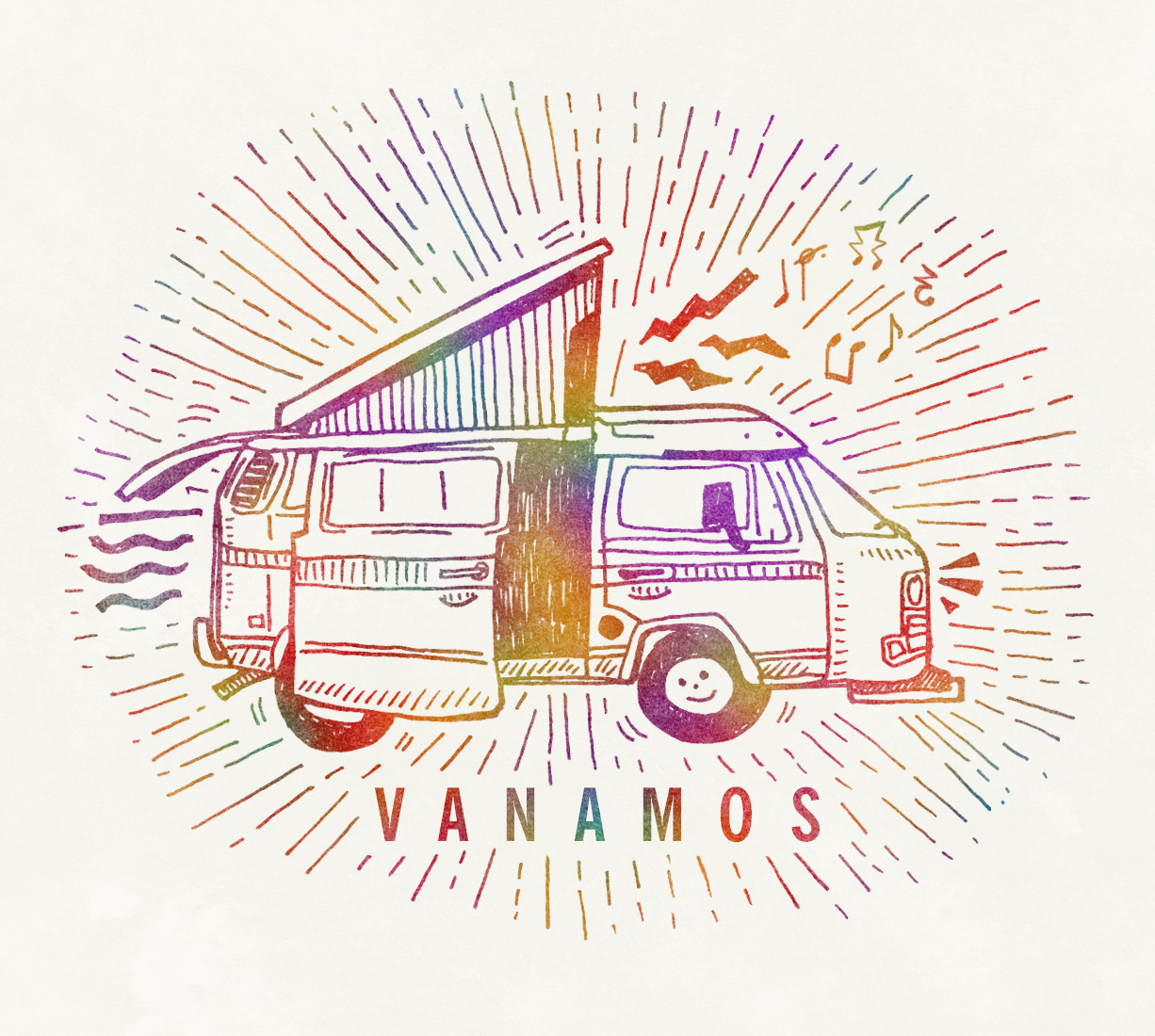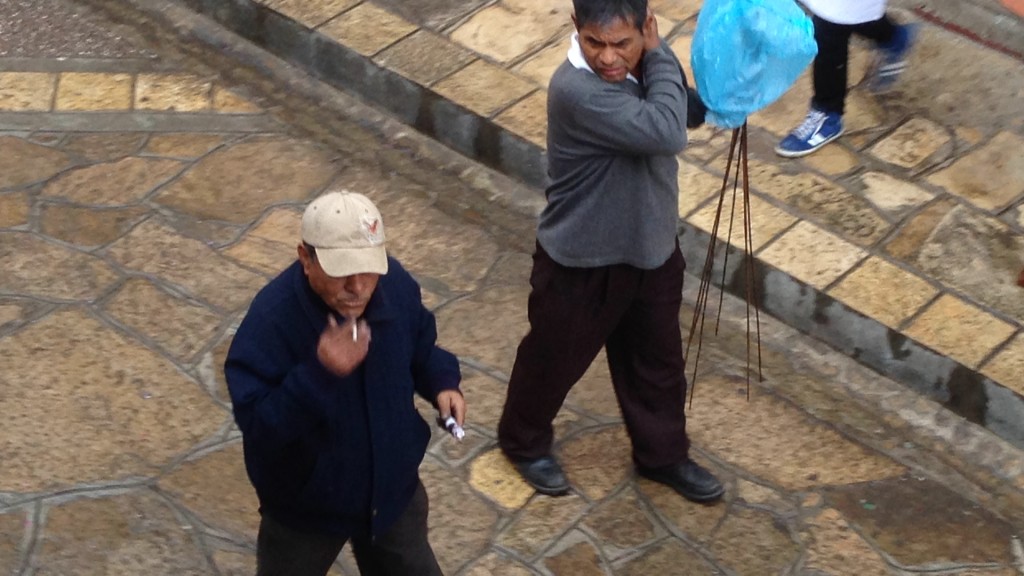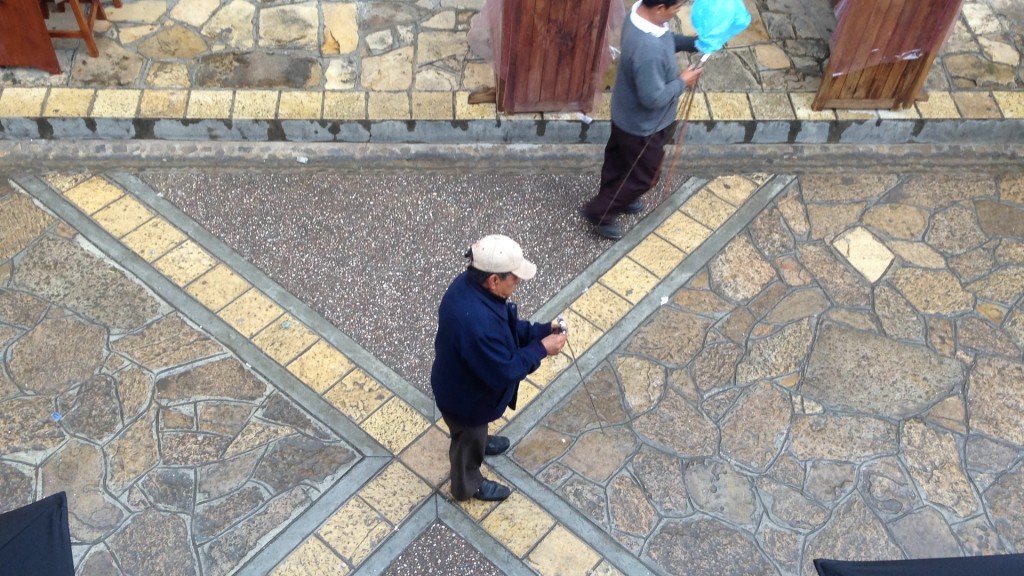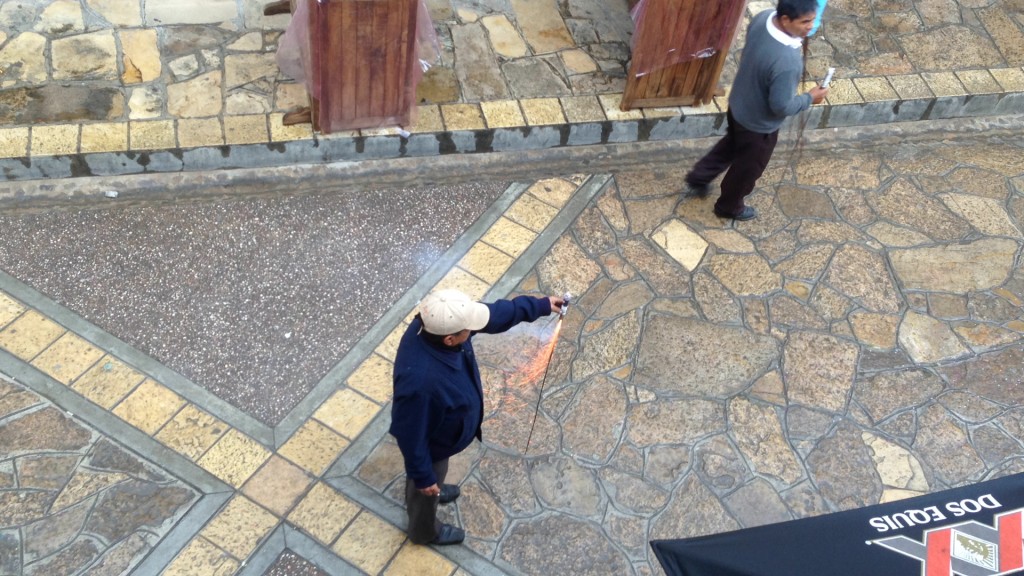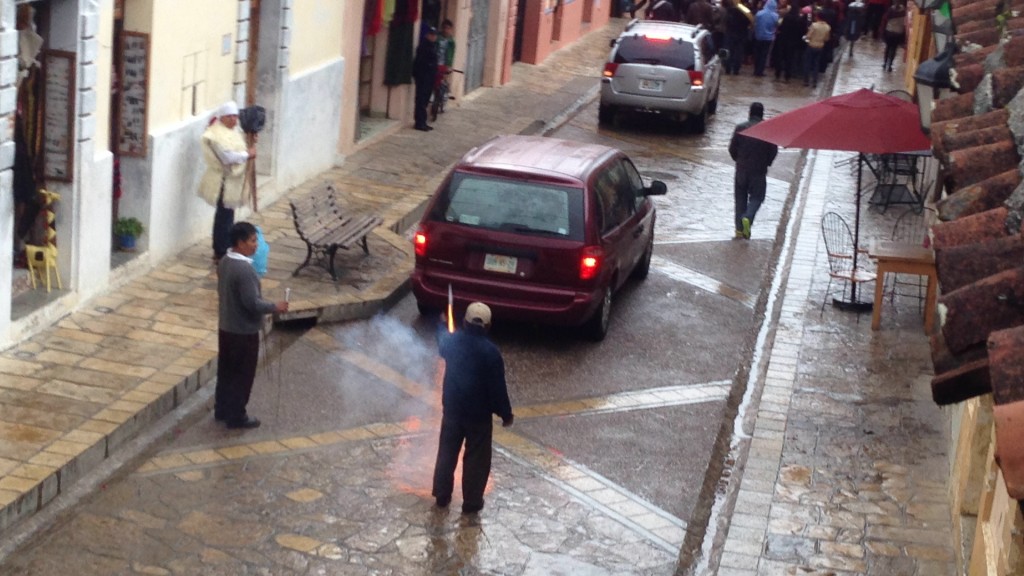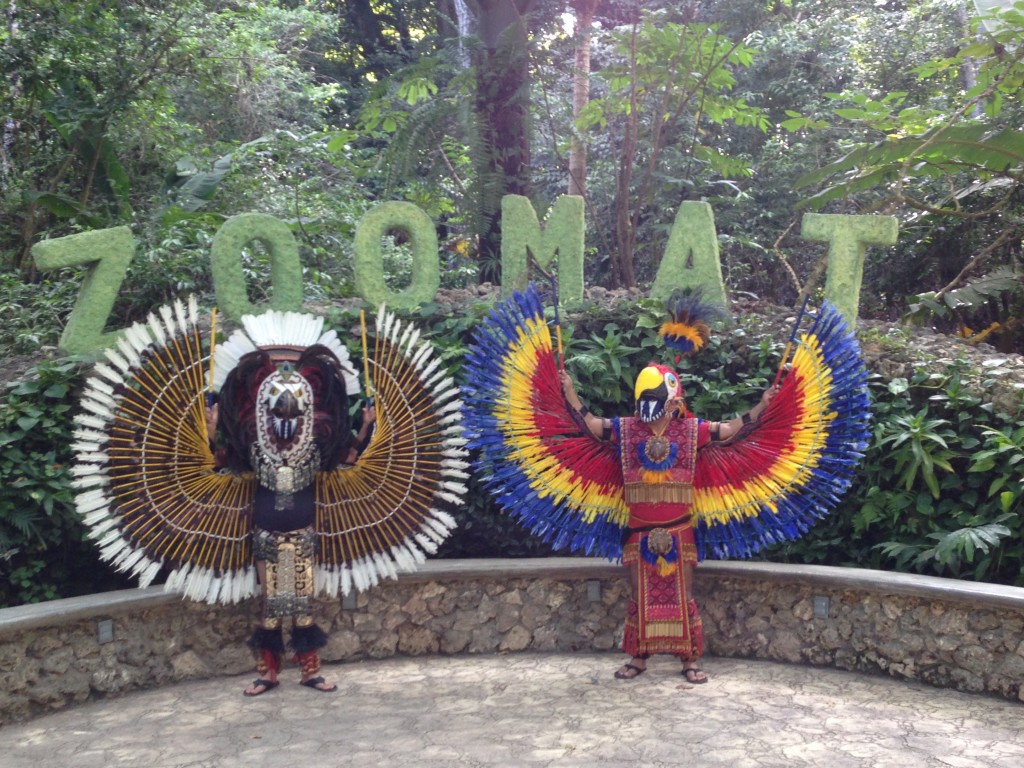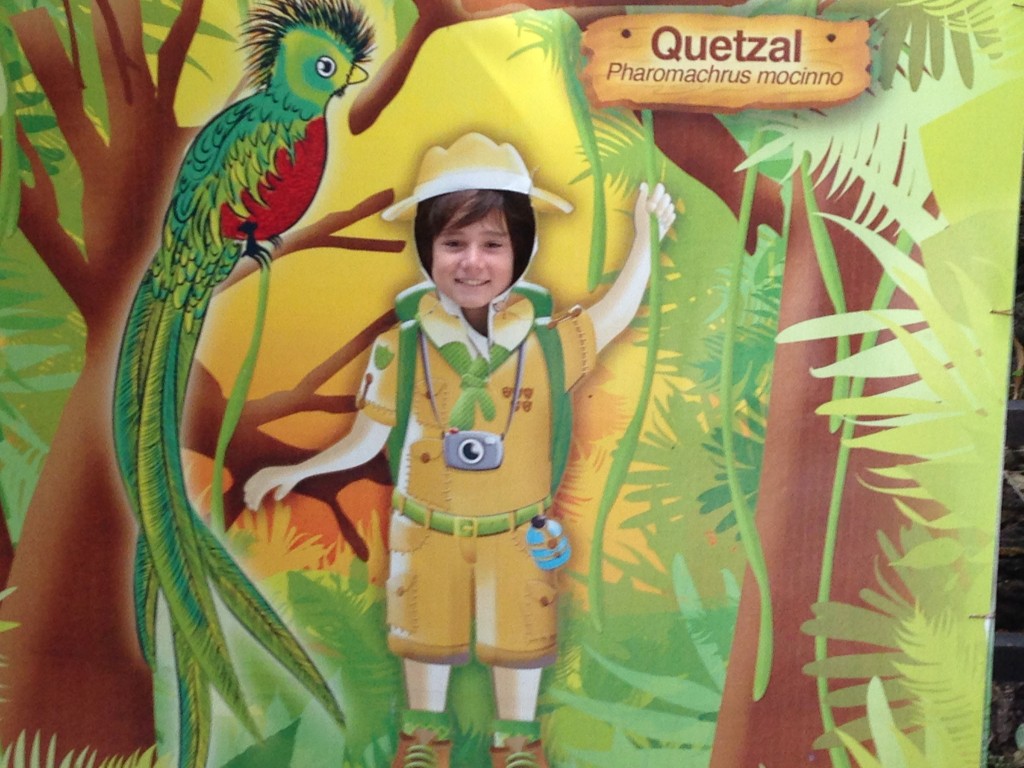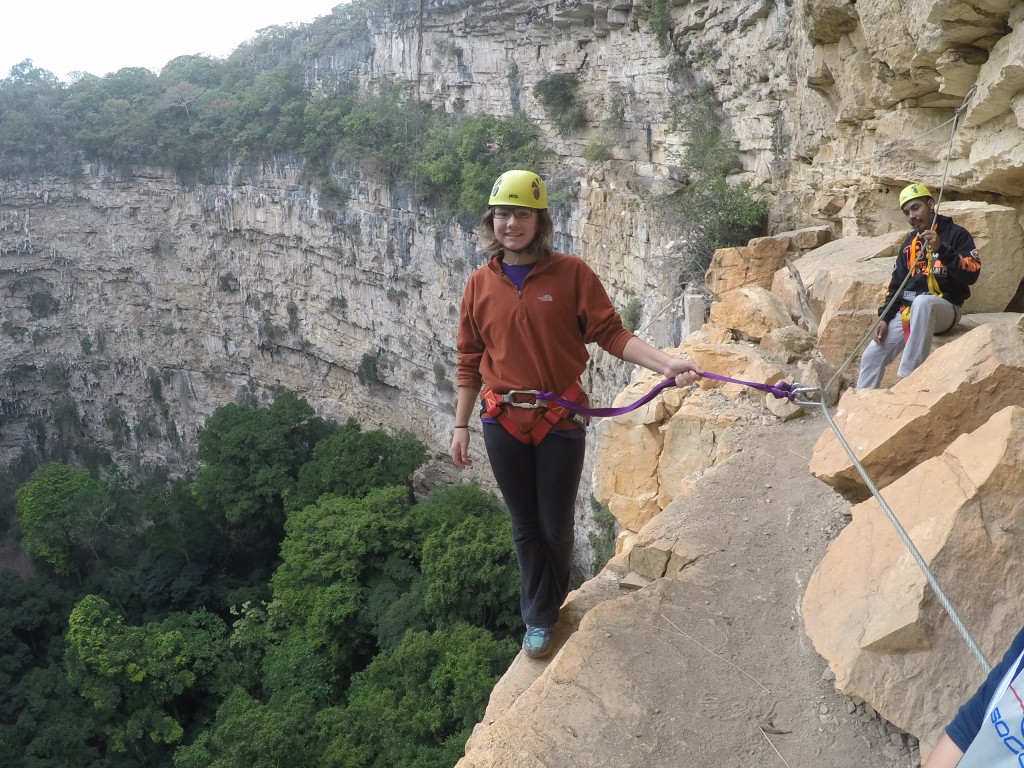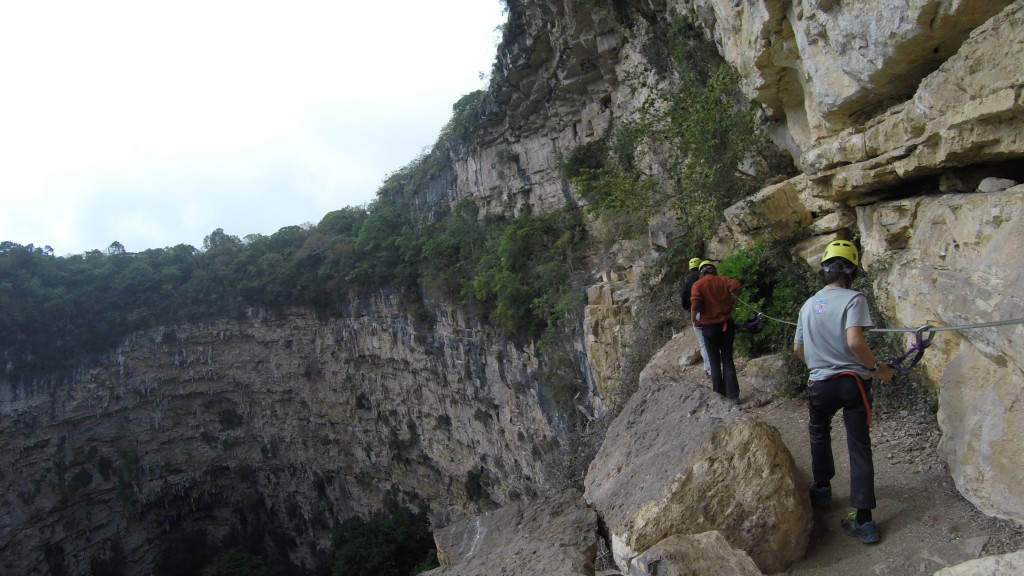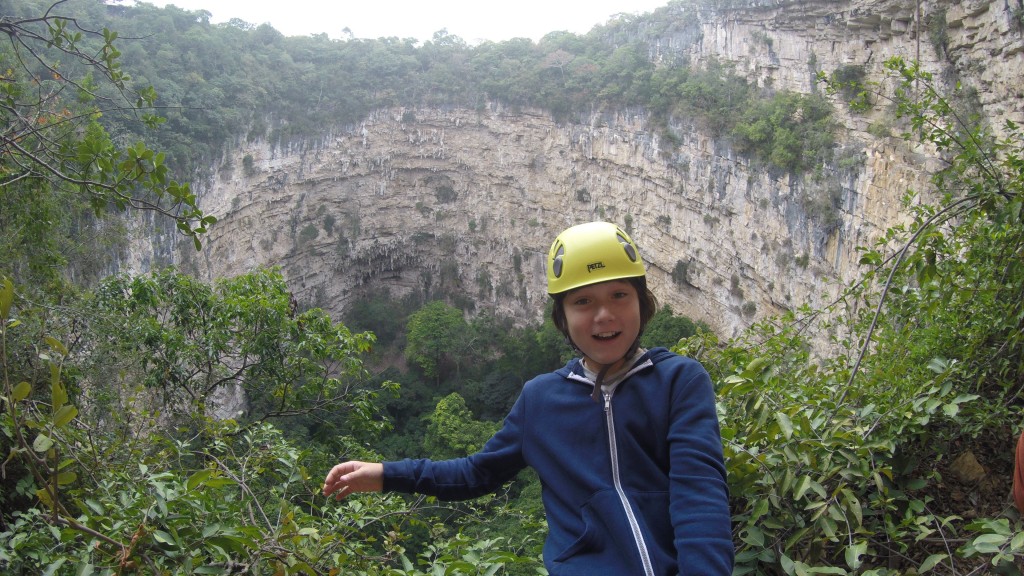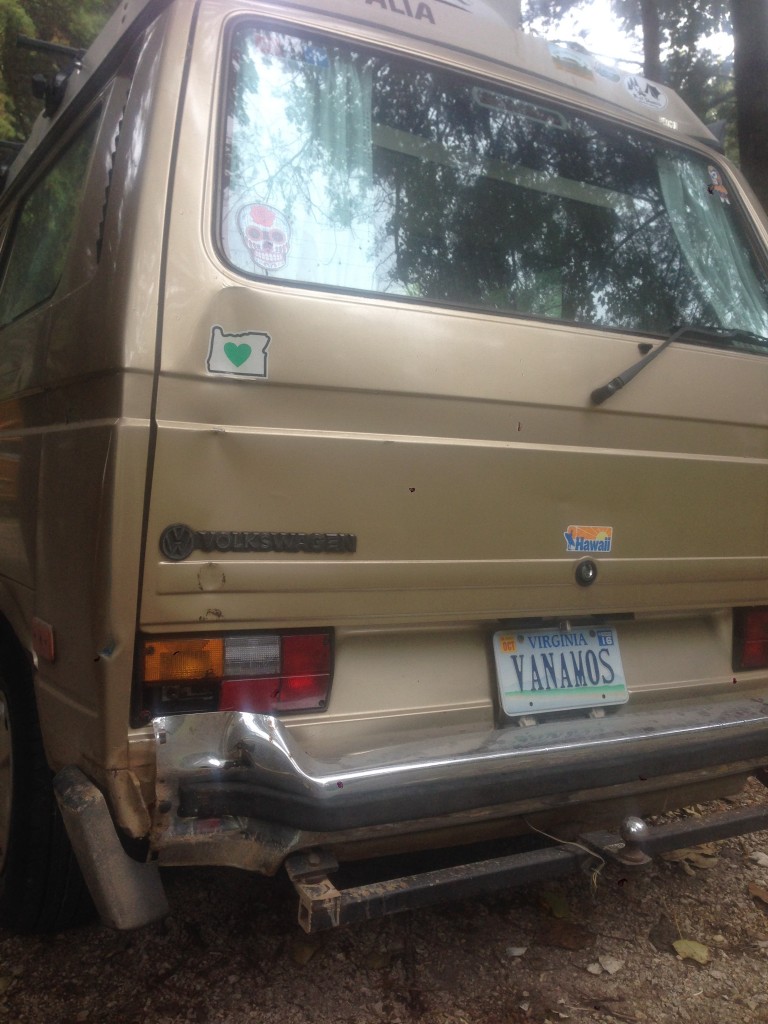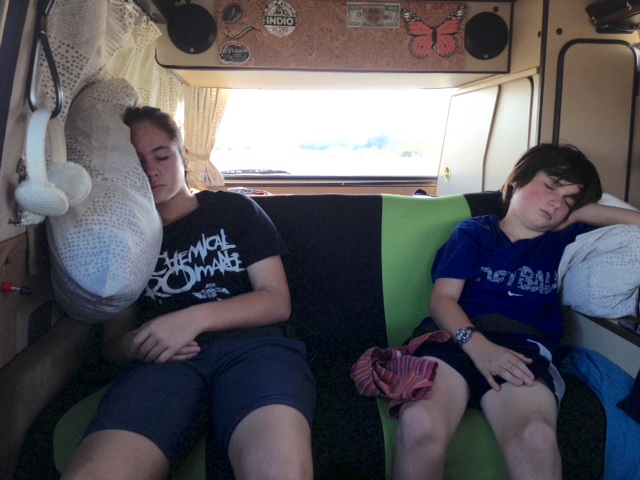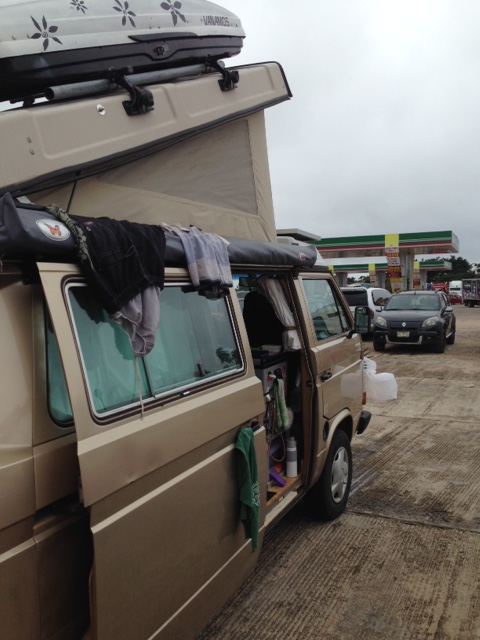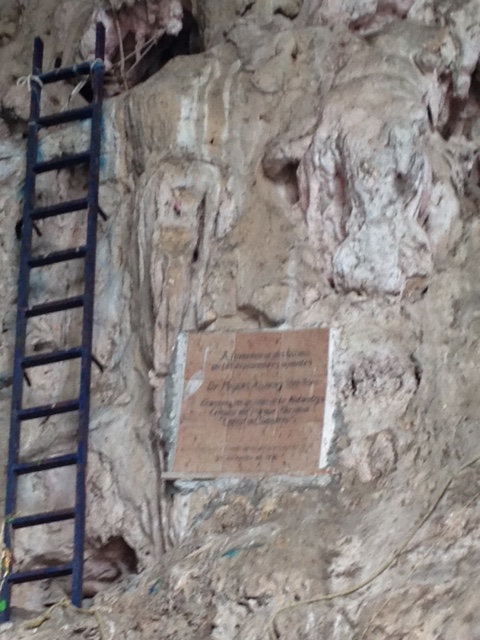In advance of our year on the road, we presented the Alexandria City Public School (ACPS) system with a thoughtful home school curriculum covering everything from animal migratory patterns to car mechanics that any self-motivated student would be thrilled and excited to study. ACPS stamped its approval and we went merrily on our way. What we didn’t consider was that we would not be bringing any self-motivated students along with us.
The Long and Winding Road
We heard several things about the road from San Cristobal to Palenque – none of them that it was an easy drive. That the road was long and winding was no surprise - it was many moons ago that I anointed Mexico the most mountainous country I’ve driven. We also heard that the number of topes was extreme – two tope towns become four and five tope towns with no discernible difference in economic or scholastic opportunities.
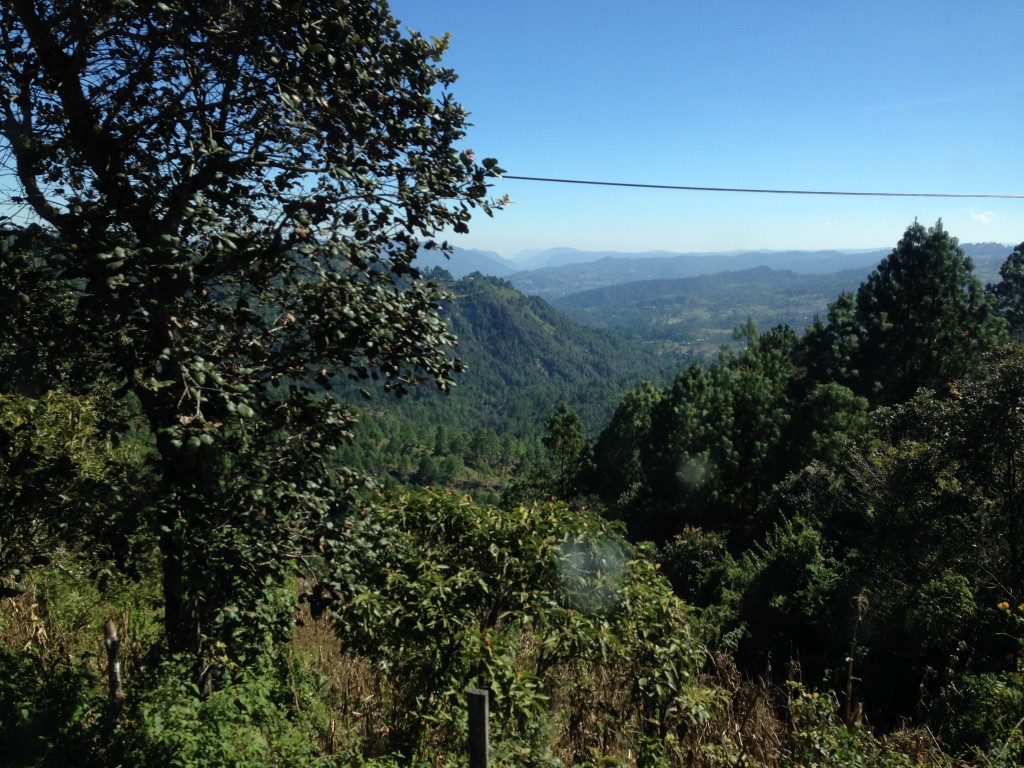
Finally, and most concerning, was that we could encounter road blocks along the way that could hold us up for hours if we weren’t willing to pay the “toll” - something like 50 to 200 pesos, depending on how well one can negotiate. Chiapas state has the highest population of indigenous peoples in Mexico and therefore, has the highest population of disenfranchised peoples. As we drive around we point out to Coconut and J all the old men and boys clearing the fields and tending the animals and the women and girls selling fruit, corn, and trinkets on the street, and they know how lucky we are for being born into the circumstances that we were.
The thing is, even though the people are breaking their backs in the fields, they aren’t seeing all of the fruits of their labors because they don’t own the land. It’s the story of how the rich get richer and the poor get more bent over. So, every once in a while the poor will set up a road block on the main road to Palenque to stop traffic – primarily trucks hauling freight – to protest their condition. I don’t know if anyone in charge who can change their plight notices this and wants to fight for them, but a side benefit is that by stopping traffic, tourists like us who have nothing to do with anything, can pay a toll to move along.
Coconut was actually excited to be stopped like this, but after all the build-up and anticipation – it’s one of the first topics of conversation among overlanders coming from or going to Palenque – we didn’t encounter a road block. I was a bit disappointed as well, because depending on where the road block was set up, I thought we might be able to get an oil change for Wesley while we waited.
A few times during our drive a mom and her dirty and sweaty kids would string up a line as we approached and try to sell us fried plantains or sugar cane for a few pesos. When we didn’t buy any of their stuff, we would hand out a few toys from the bag of junk that we brought with us for this purpose – matchbox cars, erasers in cute shapes, super balls, colored pencils, and the like.
There are a few stopping points along the road to Palenque and the first night we camped at Agua Azul, a series of waterfalls tumbling over rock crevices into pools perfect for a refreshing dip. We’d been in the highlands for the better part of two months so the jungle setting of the falls was a reminder that heat and humidity suck, but at one point after splashing around in the water on a rope swing, J was shivering and we said we would remember that feeling later that day when we were sweating again.
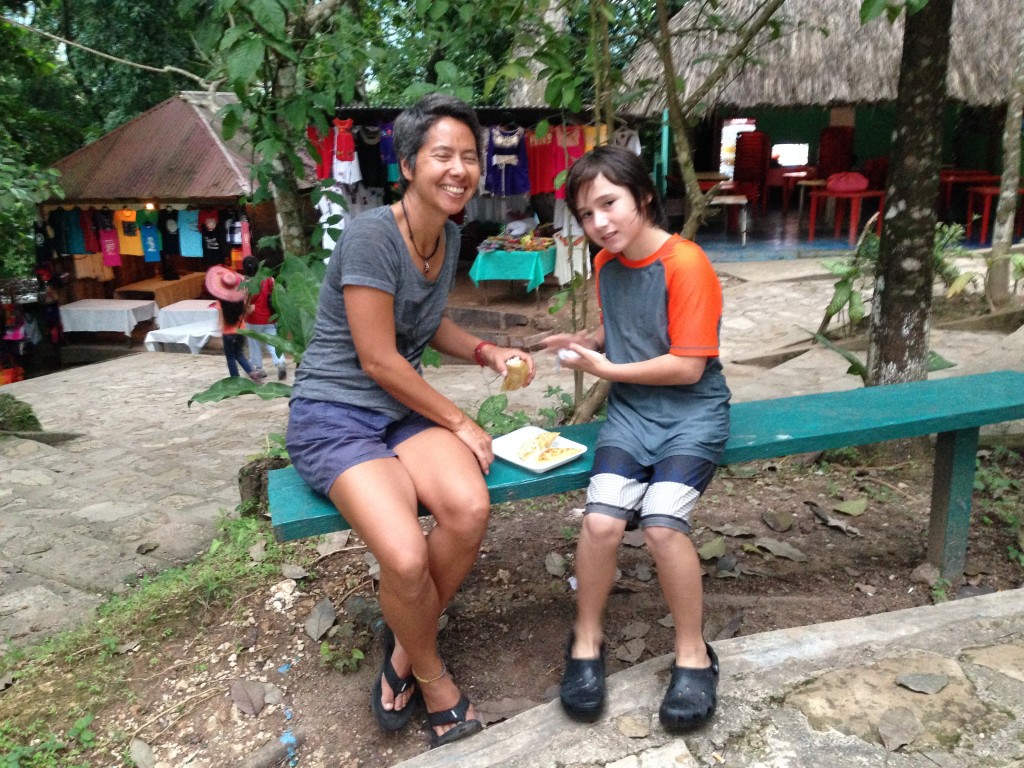
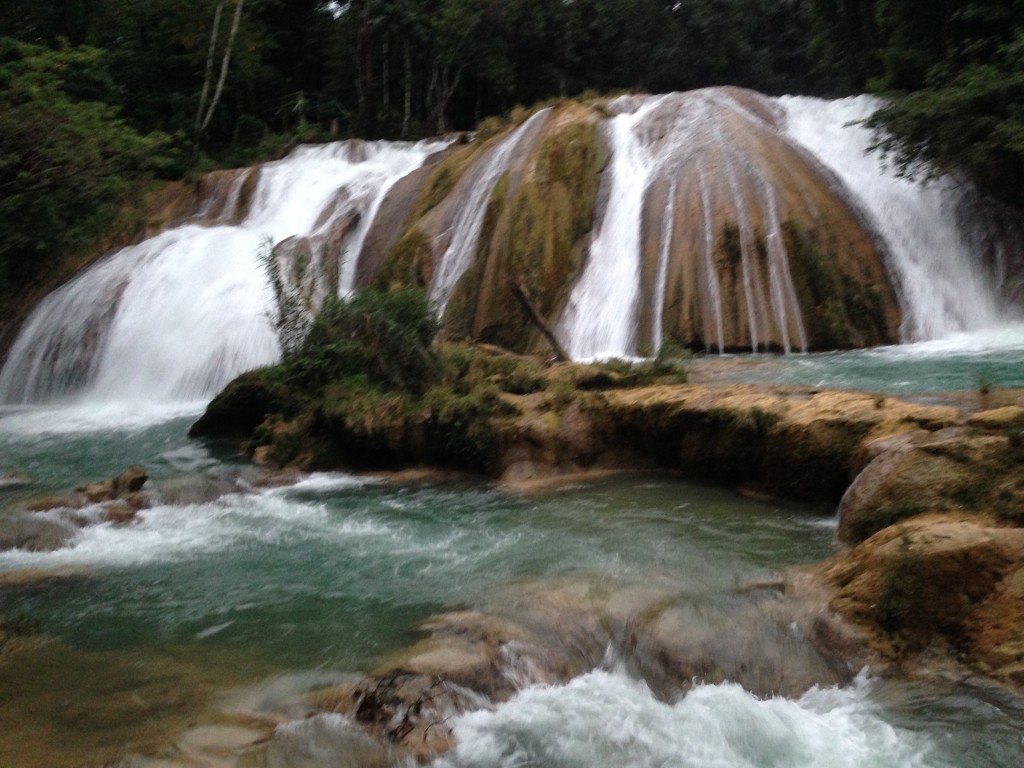
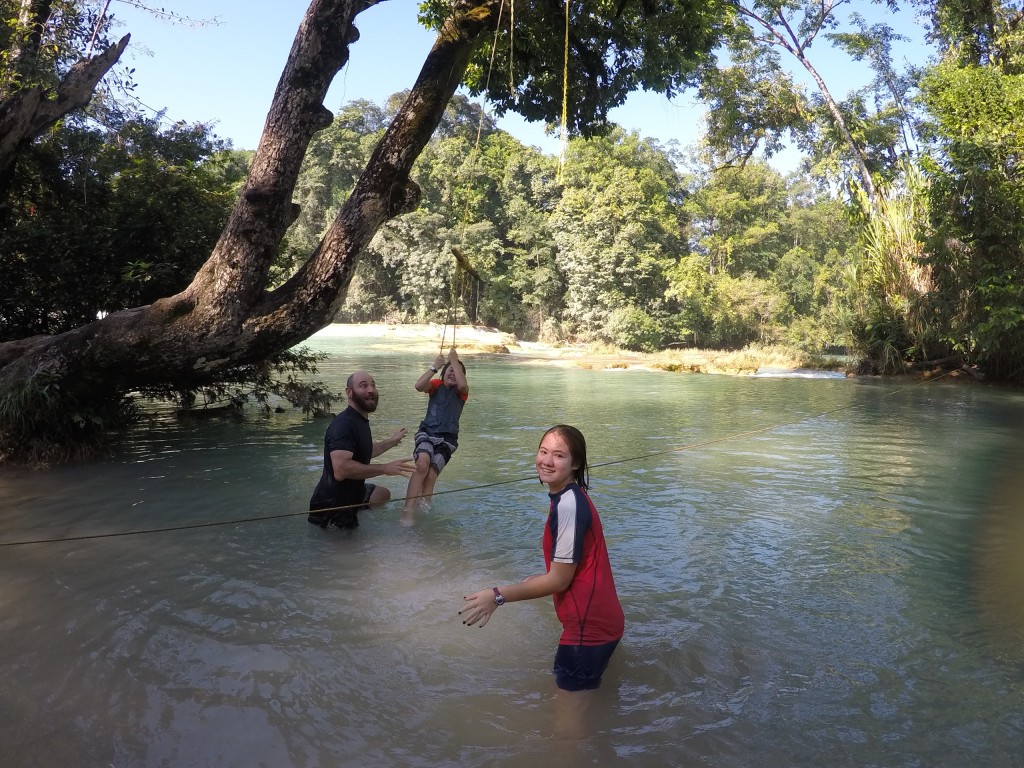
The camping at Agua Azul was pretty basic – no showers and toilets without seats that were closed after dark when all the restaurants and vendors hawking artsy-fartsy stuff went home. A bunch of people drinking beer pulled in right next to us and R was pretty annoyed so went to bed around 7 p.m. but Coconut and J decided that with the sound of the falls, we could hardly hear their noise. After a few hours the police came and chased the party away – the most effective bit of police work that I’ve seen in Mexico.
The next day – Wednesday – we stopped at Misol Ha, another waterfall with some caves behind it that we paid ten pesos each to enter to see the bat cave and underground waterfall. It was pretty cool. Then R and J and I swam in the pool in front of the main falls for a while before driving on to Palenque and the Maya Bell campground where there are still no toilet seats on the bowls.
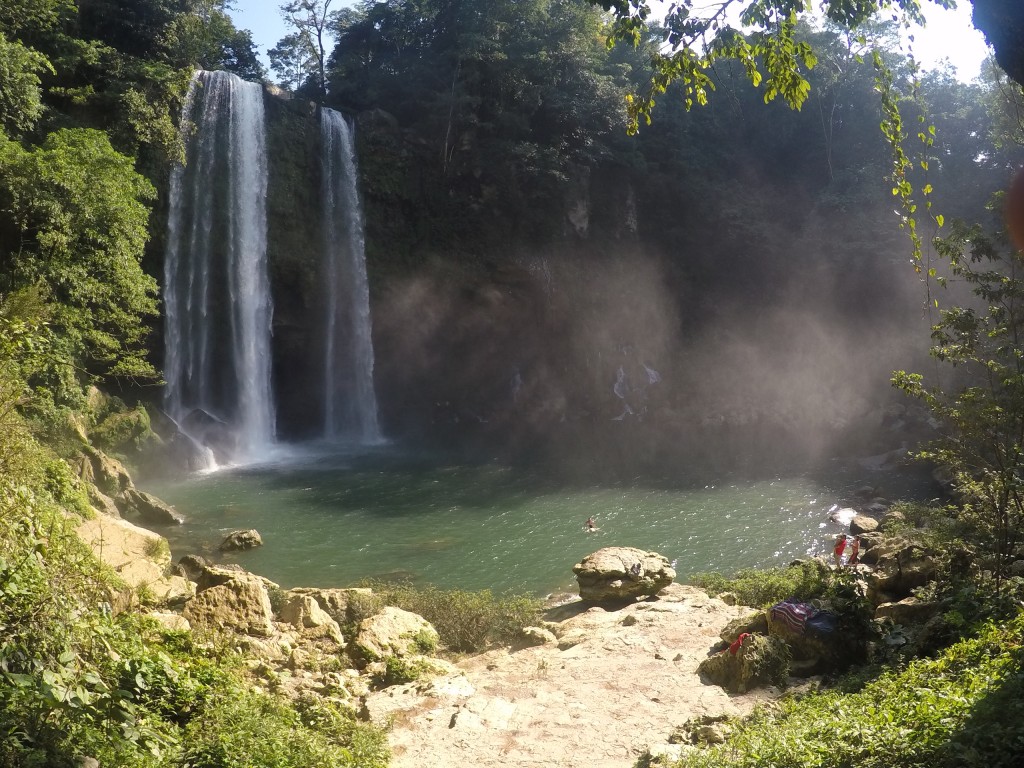
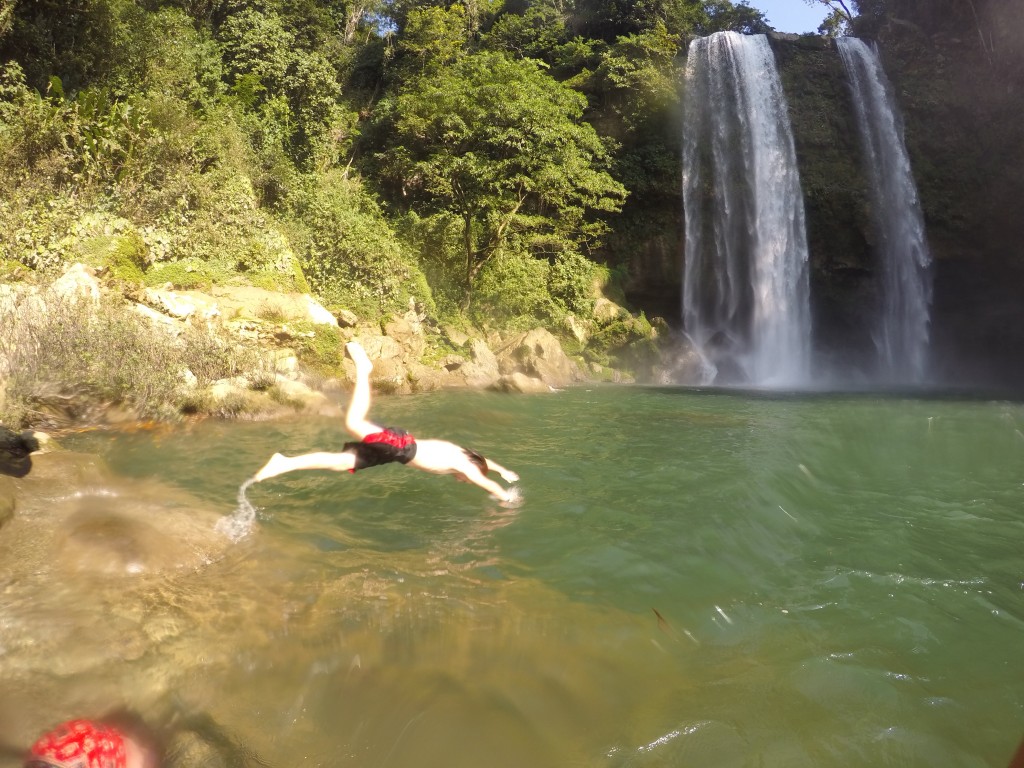

There are biting ants, however, and when Coconut and J are not in the pool or scanning the tree tops for howler monkeys, they are holed up in Wesley. J has become super sensitive to bugs and when he and I were leaving the bathroom, he spotted a cockroach so I started singing – la cucaracha, la cucaracha. He asked me who sang the song, but I didn’t know; I said that it was just a folksy song and not a song written by a band that made records. He raised his fist and said, “Yeah, I bet people didn’t sit around at Beatles concerts going, 'yeah, play La Cucaracha, man!'”
Crazy Town
Chiapas state has the most independent-minded indigenous culture in Mexico. Parts of the state were never fully subjugated by the Spaniards, and several tribes continue to deny Catholicism as the national religion and not pose for tourists’ pictures. The state even rejected joining both Mexico and the United Provinces of Central America subsequent to the eviction of the Spaniards in the 1820’s before deciding by referendum to join Mexico. We’ve witnessed some of that edginess during our short stay in San Cristobal de las Casas. We arrived during the week long fiesta for the Virgin of Guadalupe, who is the patron saint of Mexico, and she apparently requires that the band start playing at five a.m. to the accompaniment of exploding sticks of dynamite and someone yanking on the church bell 100 times every fifteen minutes. Despite the constant drizzle of rain, uncharacteristic, we are told, the people’s spirits, and the fireworks’ wicks, have not been dampened.
We didn’t plan to stay in San Cristobal for long, having just come from an extended stay in a colonial city (Oaxaca), but I ran Wesley into a telephone pole so we are grounded for a few days while it gets repaired. As we drove to a body shop recommended by someone that we just met, I described to Coconut and J how the repairman would drill a hole into the middle of the dent, insert a tool that would splay out from the inside, and then pull the metal back into shape. Instead, the body guy comes out into the rain and mud with a heavy mallet and a piece of two by four and starts banging away. In an ironic twist, he thinks he might have the van a few days so he can get the paint to match. A perfectionist.
After watching this spectacle for as long as we could take it, we started walking back to town. At a busy intersection, we saw a kid - a teenager - with a plastic liter bottle filled with gasoline. He took a swig from the bottle, spewed flames from his mouth, and then daintily dabbed his lips and chin with a greasy rag. It looked really cool, but was a depressing thing to witness. We gave him fifteen pesos. I told Coconut and J that if they ever needed money that badly they should come talk to me no matter how grouchy I am that day.
Later, while we were eating lunch at the fanciest pizza place in town, a parade came marching through the main pedestrian street. We quickly ran to the balcony of the restaurant to watch and saw an older man at the end of the line nonchalantly lighting bottle rockets with his cigarette and launching them from his hand like he was Cape Canaveral. We didn’t feel nearly so badly about this - in fact, we could hardly stop laughing it was so funny.
The fireworks culture in Mexico is quite different than what we are used to. Explosions are mandatory for any celebration, and ubiquitous at all other times. I think the school principal will often set off a rocket in lieu of opening bell. R and I had fun shopping for cojetes before our Thanksgiving celebration and the kids had fun setting them off - under my supervision, of course, for whatever that is worth. When J had a friend come over for a play date, lighting off fireworks was the featured activity.
Anyway, the rebellious strand that permeates life here seems to have trickled over - this morning even R, a notorious pacifist, got into the act. When the first volley of gunpowder was detonated outside our door several clicks before sunrise, she rolled over and said, “I’m going to kill them.”
Indian style in San Cristobal de las Casas
Since Mexico gained independence from Spain in the early 1800’s it has survived several invasions by other countries, including the United States in the Mexican-American War, and internal uprisings due to bad government that has caused it to change heads of state more often than the wind changes direction. Many of these civil wars were instigated by indigenous peoples seeking equal rights, particularly with respect to land holdings. In fact, as recently as the 1990’s, a rebel group called the Zapatistas engaged in an armed insurgency as a means to bring about social reforms for indigenous peoples in Chiapas state, where Wesley is currently parked. In some cases these uprisings bring about social reforms that redistribute land ownership to ejidos - community land holdings - for local groups native to the region. On Saturday night, we arrived at Sima de las Cotorras, an ejido of the Tzamanguimo people - who must be ancestral to Chiapas.
The Sima is an enormous sink hole in the ground, dating from who knows when, and its recent claim to fame is that it is home to several hundred green parrots which spew forth from the ground like feathery lava each morning and seep back at dusk, but only during the months from April to October. In December, the parrots are sunning themselves in warmer climates; but nobody told us this, so we bounced our way over 12 kilometers of rocks and mud to camp in the rain and cold. No matter, because the chances that we were going to be able to wake at dawn and hike the few meters to the sink hole to see the birds as they greet the day was really quite slim. Instead of seeing birds, we justified our visit to the Sima by taking a stroll around the perimeter of the interior of the hole on what we called a “danger walk”.
Being on the ejido, and witnessing what the folks have done with their opportunity to own land - nicely maintained grounds, well-built and kept cabanas, good restaurant, something to keep their children home and to take pride in - led to a Vanamos breakfast conversation comparing Native Americans with Mexican indigenous peoples.
Now, I’m just a guy with too much time on his hands, so none of what follows should be taken as gospel, but just some general reading I’ve done has learned me that before the Spaniards conquered what they came to call Nueva Espana, the native tribes like the Aztec and Maya had settled in great cities and when they warred with neighboring cities, they sacrificed the captured warriors by cutting out their hearts, or chopping off their heads. Native Americans, like the Lenni Lenape and the Apache, did not build cities but generally moved around the plains or forests depending on the season. If they got into a disagreement with a neighboring tribe, they organized a raiding party and, under cover of night, stole some of the other tribes’ horses. Comparatively, this is the equivalent of bullying the other tribe for its lunch money.
When the Spaniards came to Mexico they were viewed as bearded gods and were thrown great feasts and given women as concubines. Then they conquered and enslaved the men and took their land and its riches. When the first settlers came to America, they wore white socks pulled up to their knees and patent leather shoes. They tried to befriend the Indians because they needed their help to understand which crops to grow or else they would die. If the Indians were unfriendly, the settlers lived inside forts that they built out of sticks, just like the second little pig.
When the Mexican Indians got fed up with the Spanish Imperialists, a priest led them in revolt and they kicked them out, but this didn’t work out any better because the Church came into possession of the land. In the 1850’s, the Zapotepec politician Benito Juarez, one of the unsullied heroes of Mexican history, passed reform laws that required the Church to sell the land, but this didn’t work out any better for the natives because most of the land was purchased by rich people - not by historically oppressed peoples - and the rich people continued to exploit the natives and combat further reforms that would improve the natives’ station. This has continued to create unrest, and as recently as 1910-1920, Mexico was still engaged in widespread civil war to redistribute hacienda land to the natives. The natives haven’t owned their ancestral lands since the 1400’s and basically, they are pissed off about it. Occasionally, they get thrown a bone in the form of an ejido and it’s nice to see them take hold of the chance to preserve it in a way that the Tzamanguimo have done with the Sima.
On the other hand, as the American settlers became more comfortable with the land, and imported more guns and people, they pushed the Native Americans further and further west, signing treaties along the way that promised the Indians several shiny necklaces and a lifetime supply of alcohol. Eventually, the New Americans got tired of that game and created reservations in god forsaken places like Oklahoma where they forced the Native Americans to live with no economic options but to sell tax-free cigarettes and build casinos.
Well, it was an interesting conversation that we had, and Coconut even asked some questions about why Indians build casinos that reminded me of a very good book that I read called “Revenge of the Pequots” which details the history of Indian gaming starting from the Seminoles’ bingo parlors and the State of Florida’s unsuccessful efforts to tax the profits. The Pequots are a Native American tribe from Connecticut that was forced to open Foxwoods Casino and book multi-million dollar acts like Keith Urban and Nickelback, which is why you have probably never heard of them, but other tribes have heard of them which is why they all want to open casinos and get rich too.
Anyway, after our danger walk and lunch, we got in Wesley and drove a couple of hundred kilometers south and 1,940 meters up into the clouds, literally, to San Cristobal de las Casas, a colonial city in a valley surrounded by a pine forest. We planned to be here only a day or two before heading north to Palenque, but while we were waiting to pull into the campground Rancho San Nicolas, I got it into my mind that I would back up in case anyone coming out of the gate wanted to pass and I ended up kissing a telephone pole that someone had decided to plant two feet from the curb in the road. It did serious damage to the rear fender and dented the rear hatch so much that it won’t open. I also broke a taillight. What all this means is that we are going to be sitting in San Cristobal for a few days while Wesley gets repaired.
Three days on the road
We left Tule on Wednesday under clear, blue skies, and perfect winter morning temperatures - about 68 degrees, for San Cristobal de Las Casas, a colonial city perched at 1,900 meters in the mountains of Chiapas state. Our guidebook estimated a ten hour drive, but we knew better. We planned for 20 hours over four days.

We knew the first part of the road we would be traveling was flat and straight since we had traveled it a number of times on our visits to the market at Tlacolula, the ruins at Yagul, the frozen waterfall at Hierve de Agua, and the zip line at Caujimoloyas - it’s the only direction we ever went out of Oaxaca - but we didn’t know what to expect from the next 500 kilometers. It was no surprise, however, when the road started winding up and up because it seems like someone has grown a mountain between us and wherever we want to go in Mexico.
This is the worst type of driving to me - it’s tedious, upshifting and downshifting, keeping eyes peeled for oncoming traffic around steep curves, and we only average about 20 miles an hour, so it takes all day to go anywhere. We pledged at the outset of this trip that we would not drive more than four hours a day and would not drive consecutive days if we drove four hours the previous day, but we had to blow that philosophy up long ago or we would still be in Texas. When the road finally does reach the top of something on our mountain climbs, the views are spectacular, but then we start winding down again, and I only get glimpses of the mirador because I hesitate to take my eyes off the road for too long.
We planned to spend the first night at Ojo de Agua, a natural spring/swimming hole, near Magdalena Tlacotepec (which is near Ixtepec, in case you want to look it up.) The campground was essentially a dirt spot under a tree, surrounded by other dirt spots, next to a large parking area strewn with litter and burned out spots where litter is burned, and infested by flies and stray dogs. In other words, it’s a dump, and in the middle of the dump is this really pleasant, clean water swimming pool made by damming a natural spring - it reminded us of Barton Springs in Austin, TX, but not nearly as cold. We got out our goggles to watch the little fish in the spring nibble at our toes and other exposed areas of skin for what amounted to a free fish spa - which tickled - until a bigger fish would take a nab at a toe with intentions of making it breakfast.
And we all finally got to use our Turbo Toilet because the public restrooms closed at 6 p.m.
We finally reached Chiapas state on our second day of driving after spending more than six weeks in Oaxaca. After we passed through the wind tunnel of La Ventosa, the narrowest point of the Mexican isthmus where winds can reach speeds strong enough to rip your teeth out, the drive was a pleasant stroll through rolling mango groves and wavy grass fields, more reminiscent of the winding mountain roads I’ve driven in the States, and lacking the steep grades so common to Mexican road-building; most of the time it’s as if the engineers were late for siesta and said, “Fuck going around the mountain. Let’s just go over it.” Coconut and J spent the day in the back seat doing math homework, playing video games together, and taking a nap - just the kind of bonding experience we hoped they would have.
We planned to camp at Aguacero, a waterfall described in our guidebook as a gorgeous series of frothy stairs that tumble and spray, but when we pulled up at 5:05, the gate was locked. We later found out that Carlos, the guy from town who has the keys, calls it a day at 5 p.m., not at 6 p.m. like the guidebook suggested. I did hike down the couple of hundred meters to the campground, which was abandoned except for two stray dogs, one of which growled but turned tail after I stooped to pick up a rock (I didn’t bring my stick.) The waterfall is about 700 stairs and a 20-minute jungle hike from the campground, so all I could see when I peered over the wall was the river far below in the canyon - it was pretty, but I forgot my camera so no photo.
After some debate, R and I decided not to camp at the entrance to Aguacero, which would have meant that we basically set up shop right on the dirt road in front of the gate, so we turned Wesley around to bump the 8 kilometers back to the main road and head in the direction of Ocozocoatla. By this time, though, it was after six, dark, and had started to rain. I couldn’t see where in carnation anything was, including the road, so when we made a wrong turn for the other campground we could have stayed, we decided to head to the nearest Pemex gas station to stay for the night. As our friend Andre said over coffee and cake in our San Felipe house, you haven’t overlanded unless you’ve slept at a Pemex. So, finally, check! And it actually turned out to be one of the quieter nights that we’ve spent in Mexico - no stupid, barking dogs - though Coconut did say that I snore.
After a leisurely morning spent doing this and that in the Pemex parking lot, we drove through the modern city of Tuxtla Gutierrez, which proudly boasts a traffic light for each of its 540,000 residents, to get to the Canon del Sumidero so we could take a boat ride up the canyon. This pre-historic fissure in the earth has a variety of birds that may get eaten by the 240 or so crocodiles that live in the river, some towering rock formations rising out of the mist that reminded us alternatively of the cliffs of insanity or something from the Lord of the Rings, and, unfortunately, lots of floating plastic bottles. At one point, the canyon wall was 300 meters high, the water 100 meters deep, the boat was traveling at 60 kilometers an hour, and the temperature was 15 degrees Celsius. That’s a lot of numbers to add together, but it can be summed up like this - it was really cool.
Migrant Story
With all the free time R and I have had each day after sending the kids to school, I’ve been able to read a lot of books. In addition to Scott O’Dell, Trenton Lee Stewart, and books by someone named J.K.Rowling, that were recommended to me by Coconut and J, I was also able to finish a book titled “Enrique’s Journey” which has particular relevance to us as we make our way south through Mexico and Central America. The book is an account of a Honduran boy’s life and the reasons that compel him to undertake a dangerous journey north through Mexico on top of freight trains and running from gangsters and authorities to find his mother in North Carolina. Enrique’s mother had left him and his sister in the care of family members when Enrique was five and departed for “El Norte” with the hope of making money to feed and support them. After ten years of mostly downs in his life, and overwhelming feelings of loss, abandonment, anger, and despair, and with his own economic prospects dim, Enrique sets off on his own journey north to find his mother. The book is compelling to us for a number of reasons.
First, the story is unfathomable. R and I can’t imagine, and I daresay you can’t either, the despair a mother must feel to leave her children behind to travel thousands of miles with the hope that she can land a job that will allow her to save enough money to, first of all, send money home to feed them, and second of all, either bring the children illegally to the U.S., or return home in a few years with enough money to buy land, build a house, and start a business. It is serendipity that I was born a U.S. citizen and my biggest problem is often whether to order one pizza or two, and what toppings.
In describing Enrique’s journey, the book goes into detail about the many dangers faced by him, and migrants generally, as they travel through Mexico. There is no means for them to immigrate legally so they are reduced to jumping on and off moving trains, losing limbs or their lives when they miss a step or handhold, getting robbed and beaten by gangsters in Chiapas, Mexico, getting robbed and killed by Mexican authorities throughout the country, starving, freezing, and being caught and sent back south (usually to Guatemala) to try again. Enrique was caught by Mexican immigration and sent back to the Mexican-Guatemalan border town seven times.
As we all have no doubt heard from Donald Trump, it’s not a unique thing for people living in Central America, particularly Guatemala, El Salvador, and Honduras, to immigrate to the U.S. to look for work. What is often missing from the sound bites, however, is any information on the reasons why people are compelled to leave family and friends behind to travel to a foreign country where they are often discriminated against, taken advantage of, and looked at suspiciously. I mean, let’s get serious, these people are not coming here so they can clean fast food joints’ toilets for minimum wage and then go out and get drunk and rape people and commit other crimes. I’m not an expert on this issue so this blog is not going to get into the many social and economic reasons why people might put their lives and families at risk to get to the U.S.; I encourage you to read the book instead because Sonia Nazario, the author of “Enrique’s Journey,” is a journalist and she does offer explanations. And let’s just say that the U.S. is not innocent - its historical Latin American policies are at least somewhat responsible for the lack of current economic opportunities within the countries. But let’s not go there, or dwell on the fact that our Congress still hasn’t come up with a sensible immigration reform proposal; instead focusing on partisan issues like trying to impeach the Commissioner of the IRS and restrict the sale of oranges at government cafeterias. In somewhat related current events - R and I recently read a NY Times article about how the U.S. has outsourced its border patrol.
A second reason why the book was so compelling to us was that when we leave Oaxaca in a few weeks, we will be heading directly into the belly of the beast - Chiapas state in Mexico - where Central American migrants face the most risk, including at the hands of Mexican immigration officials, who are just as likely to shake a migrant down as a bandit or gangster. Actually, we are more heading into the calf and ankles of the beast because we aren’t going to the places where migrants cross the border and hide in cemeteries and marshes to avoid detection from bandits who rob and beat them and from Mexican authorities who rob and beat and deport them, and we certainly won’t be riding on top of any freight trains, but to see this stuff first hand would be pretty fascinating. This is a pretty good overall summary of the dangers migrants face. There are also heart-warming stories - check this out.
Finally, a few weeks ago when we were driving back from Hierve el Agua, the frozen waterfall, we reached the top of a mountain and there was a guy walking alongside the highway, so we stopped to ask if he needed a ride. I may have stopped because I was still feeling the good will from getting a ride myself that morning after I had walked up from the campground to a store in town to buy some milk for our cereal and someone heading back down the hill stopped and told me to climb in. It turned out the guy at the top of the mountain was heading to Oaxaca city, which was where we were going - an hour’s drive away, so it was good for him that we did stop because even Wesley could get him there a lot faster than it would have taken him to walk there.
This guy had left a wife and two sons in Guatemala a few weeks before and was heading to the U.S. to make enough money to buy land. Two years, he thought. He had just been robbed of his last 400 pesos by a taxi driver who promised to take him to Oaxaca, only to kick him out after driving for a short while, and he hadn’t eaten since the day before. We gave him a few oranges and a can of beans - good hobo grub - and dropped him at the migrant shelter in Oaxaca where he would be able to stay and eat for a few days. Then he would be back on the road, just like we will be in a few weeks. Though, we are each writing very different stories.
